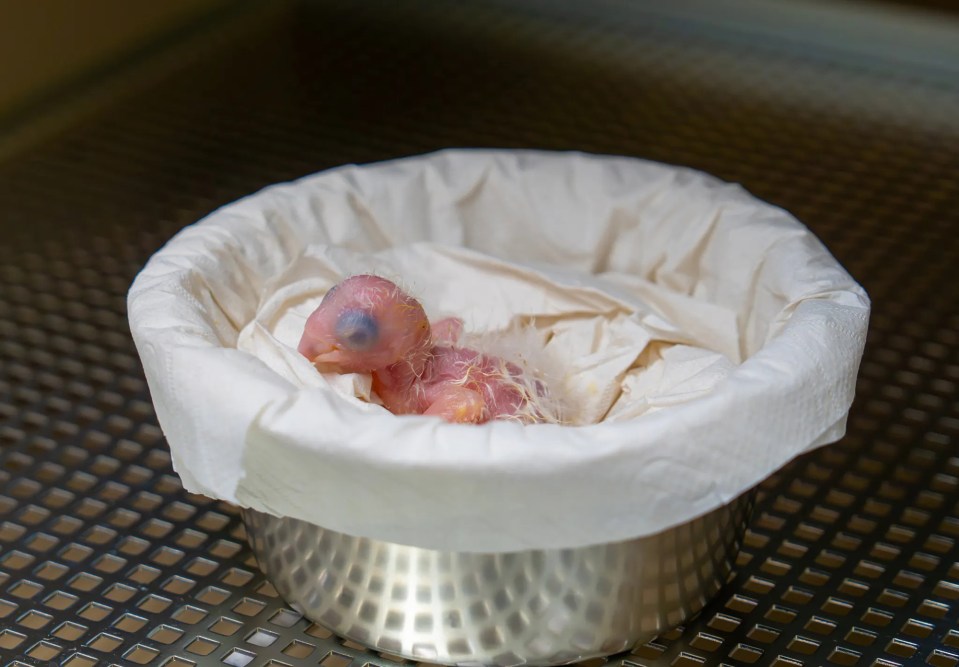A RARE blue parrot declared extinct in the wild has hatched for the first time at a conservation centre, sparking new hope for the species.
The Spix’s macaw chick was born at the Centre for the Conservation of Endangered Bird Species in Pairi Daiza, a zoo in Cambron-Casteau, Belgium, on September 21.
Pairi Daiza/newsXThe birth of the baby is seen as a major breakthrough in attempts to save the world’s rarest parrot[/caption]
Pairi Daiza/newsXThe chick human caretaker has to feed the parrot every two hours[/caption]
It is the first chick of its species to hatch at the park after 100 previous eggs failed to be fertilised, marking a major breakthrough in an international breeding programme to save the world’s rarest parrot.
The zoo said: “Egg 101 is a true miracle of life, the result of years of effort and patience,” and described it as “a birth more precious than gold.”
Specialists decided to remove the egg from its inexperienced parents before it hatched to increase the chick’s chances of survival.
Its caretaker Thomas Biagi said having to feed the chick every two hours was exhausting but motivating because “we’re literally holding the future of one of the world’s most endangered species in our hands.”
The Spix’s macaw, native to north-eastern Brazil and made famous by the animated film ‘Rio’, was declared extinct in the wild more than 25 years ago by the International Union for Conservation of Nature (IUCN).
Only a small number of birds survive today in breeding programmes around the world.
Pairi Daiza joined the conservation effort in 2018 in partnership with Brazil‘s Chico Mendes Institute for Biodiversity Conservation and the Sao Paulo Zoo.
Twelve Spix’s macaws are currently being cared for at the Pairi Daiza Conservation Centre, which operates behind the scenes and is closed to the public to protect the birds from stress.
The new chick will not be reintroduced into the wild but will become part of the breeding population to help ensure the species’ long-term survival.
The news comes after a giant fish-eating spider once thought to be extinct in Britain has been spotted creeping back into UK homes — and experts say it’s making a “huge comeback”.
Once on the brink of extinction, the spider’s return is being hailed as a major conservation victory by the Royal Society for the Protection of Birds (RSPB).
The Fen Raft Spider, which can grow as large as a human hand, has reappeared in parts of Norfolk, sparking both fascination and fear among residents.
These semi-aquatic spiders were almost wiped out in the UK by 2010 due to habitat loss, but after years of conservation work, their numbers are rising rapidly.
The Fen Raft Spider is one of Britain’s largest arachnids and has an appetite to match its size.
It hunts insects, other spiders, damselflies, dragonfly larvae, and even small fish and tadpoles, using its long legs to skim across water and ambush prey.
In April this year, a tortoise facing extinction in the wild has been hatched at a Scots amusement park.
The red-footed tortoise is being reared by staff at Amazonia, within M&D’s Scotland’s Theme Park, Motherwell, Lanarkshire.
Red-footed tortoises are native to the dry and wet forests and grasslands of Central and South America.
They face a high risk of extinction in the wild due to threats such as
habitat loss, hunting and the pet trade.
They are classes as reptiles and generally average 12in as adults, but can reach over 16in.
They can live for 50 years in captivity.
The tortoises’ natural habitat ranges from savanna to forest edges around the Amazon Basin.
They are omnivorous tortoises, consuming a wide assortment of plants, grasses, flowers, fruit and fungi, as well as the occasional earthworm.
Pairi Daiza/newsXThe tiny parrot was bon on September 21 at a Belgium zoo[/caption]
Pairi Daiza/newsXThe rare Spix’s macaw is native to north-eastern Brazil[/caption]

